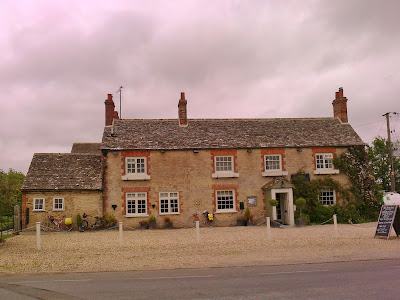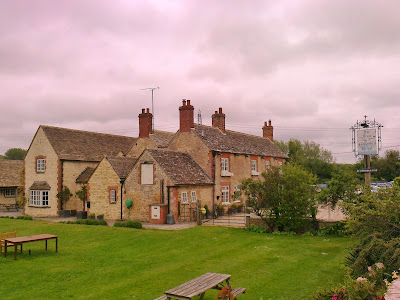David Sharp was Vice President of the Ramblers and he first recognised the idea of a Thames path and campaigned for it vigorously. David and his wife Margaret had explored the river for over forty years as the path took shape. He is the author of' 'The Thames Path in the Country' an official National Trail guide along with 'The London Loop'.
LECHLADE TO RADCOTE BRIDGE
We arrived in Lechlade, Gloucestershire, during the Lechlade music festival and the air was throbbing with the sounds of distant drums and guitars as the sun shone. Usually the first thing on our agenda is to visit the parish church to get a sense of the history of a place and Lechlade has a very fine church indeed! It is a 15th Century perpendicular church with mostly 19th Century interior furnishings. The church was completed in 1476 and stands on the site of a much earlier structure. Dedicated to St. Lawrence, it is easy to see why this beautiful parish church at Lechlade inspired Shelley to write his stanzas in 1815:
A Summer Evening Churchyard, Lechlade, Gloucestershire
THE wind has swept from the wide atmosphere
Each vapour that obscured the sunset's ray,
And pallid Evening twines its beaming hair
In duskier braids around the languid eyes of Day:
Silence and Twilight, unbeloved of men,
Creep hand in hand from yon obscurest glen.
They breathe their spells towards the departing day,
Encompassing the earth, air, stars, and sea;
Light, sound, and motion, own the potent sway,
Responding to the charm with its own mystery.
The winds are still, or the dry church-tower grass
Knows not their gentle motions as they pass.
Thou too, aerial pile, whose pinnacles
Point from one shrine like pyramids of fire,
Obey'st I in silence their sweet solemn spells,
Clothing in hues of heaven thy dim and distant spire,
Around whose lessening and invisible height
Gather among the stars the clouds of night.
The dead are sleeping in their sepulchres:
And, mouldering as they sleep, a thrilling sound,
Half sense half thought, among the darkness stirs,
Breathed from their wormy beds all living things around,
And, mingling with the still night and mute sky,
Its awful hush is felt inaudibly.
Thus solemnized and softened, death is mild
And terrorless as this serenest night.
Here could I hope, like some enquiring child
Sporting on graves, that death did hide from human sight
Sweet secrets, or beside its breathless sleep
That loveliest dreams perpetual watch did keep.
Percy Bysshe Shelley (1792-1822)
St Lawrence Church with its spire added in 1510
when the tower was strengthened following a fire
Walking towards the altar up the nave with its 15th Century arches one notices the splendid late 19th Century wooden screen which at one time was 'white oak' but years of polishing has stained it brown. The organ in the east end of the north aisle is late 19th Century by Nicholson of Worcester and there are 864 pipes! The pulpit which is 1882 rests on a 15th Century base which was probably the original base for the font. The lectern is also of 1882.
Nave
The font dates from the 15th Century and there are some traces of colour visible upon it which is certainly medieval. The font cover is 18th Century.
Font
The great East window dates from around 1510 and a 16th Century door leads from the chancel to the sacristy, bearing the carving of a pomegranate which is the symbol of Katherine of Aragon, who between 1501 and 1535 held the Manor of Lechlade.
Altar
Over the altar is a particularly fine late 19th Century reredos carved in oak. On our visit a nest of bees had taken up residence above the north window of the altar.
Altar
On the east wall of the north aisle is a very striking carved figure of St. Agatha. The 15th Century carving was found in the Old Vicarage garden and restored into the church in 1981.
St Agatha
The south chapel was originally dedicated to St. John the Baptist. When the south chapel was restored in in 1953 it was dedicated to St. Blaise, Bishop of Cappadocia and patron saint of wool-combers.
The south chapel
Side altar in the south chapel
View from Lechlade Bridge also known as Ha'penny Bridge
Lechlade Bridge was built in 1792 and pedestrians paid half penny to cross it up until 1839.
View back to St Lawrence Church
Lechlade Bridge with view of Toll House
Old Father Thames at St. John's Lock
The statue of Old Father Thames at St. John's Lock, near Lechlade was commissioned in 1854 for Crystal Palace. It was then mounted at the Thames Head Spring before residing where it currently sits today.
We camped at the camp site owned by the Swan Hotel Pub at Radcote Bridge. The bridge with its three Gothic arches was built in the early 12oo's of Taynton stone and it was nearly destroyed in the Battle of Radcote Bridge of 1387 and also again during the War of the Roses 1455-1487. Unfortunately Radcote Bridge cannot be considered to be the oldest bridge on the Thames as it spans a side channel and not the main river!
At the end of the day we had seen eleven pill boxes and walked approximately 6.3 miles from Lechlade with full camping gear.
RADCOTE BRIDGE TO NORTHMOOR LOCK
The next day we set off around 11 a.m. after watching the swifts fly gracefully along the river. We got caught in a rain shower at Rushey Lock, a beautiful pound lock built in 1896. The weir is a Thames Paddle and Rymer weir. The rain stopped and the clouds cleared to reveal the beautiful sunshine once more!
The Trout Inn
The Trout Inn
The Teapot Topiary House
The Topiary House
Pillbox
The Trout Inn at Tadpole Bridge
(a late 18th Century single arched bridge)
The Trout Inn
The river's beauty was endless!
Another Pillbox
Tenfoot Bridge
Tenfoot Bridge
Pillbox
Footbridge
Gate onto Footbridge
Footbridge
View of Thames from footbridge where we watched
the fish glide in the shallows
Shifford Lock where we had lunch!
Shifford Lock
Interesting Insect House at Shifford lock
Shifford Lock
Newbridge
Newbridge is the oldest bridge across the Thames and was built in 1250 by monks of Taynton stone. It originally had fifty-one arches.
The Rose Revived Inn
The Rose Revived is a very picturesque pub that has a lovely beer garden beside the Thames in view of the bridge which will be very difficult to walk past and ignore the wonderous atmosphere inside!
Looking back to Newbridge and the Rose Revived Inn
Meadow
Camping at Northmoor Lock and Weir
We camped at Northmoor Lock with the sound of the weir in the air as we drifted to sleep. Today we saw eight pillboxes and walked 13 miles.
NORTHMOOR LOCK TO SWINFORD BRIDGE
Leaving Northmoor Lock and weir
This meadow had no signs or sounds of modern life!
After Pinkhill Lock and towards Swinford
Swinford Bridge
We ended the days walk at Swinford Bridge because of the transport links to Oxford and the rail station and had walked approximately 6 miles. Throughout the whole three days of walking and camping the air was thick with mayflies and damselflies and cuckoos and curlews seemed to haunt our every step amid the buttercups, cow parsley and clover!
Swinford Bridge was a toll bridge built for the Earl of Abingdon about 1770. The walking tax to cross the bridge was abolished in 1835.
SWINFORD BRIDGE TO OSNEY BRIDGE, OXFORD
Swinford Bridge
Swinford Bridge
Eynsham Lock
Eynsham Lock
The winding path
King's Lock
walk past the iron boundary marker dated 1886 and over the old two arched bridge near the Trout Inn
Godstow Abbey remains
Godstow Abbey
Godstow Abbey
Looking back to the Abbey
Godstow Lock
Godstow Lock near Oxford is a pound lock and Lewis Carroll picnicked near here with his good friend Henry Liddell.
Godstow Lock Medley Footbridge




















































